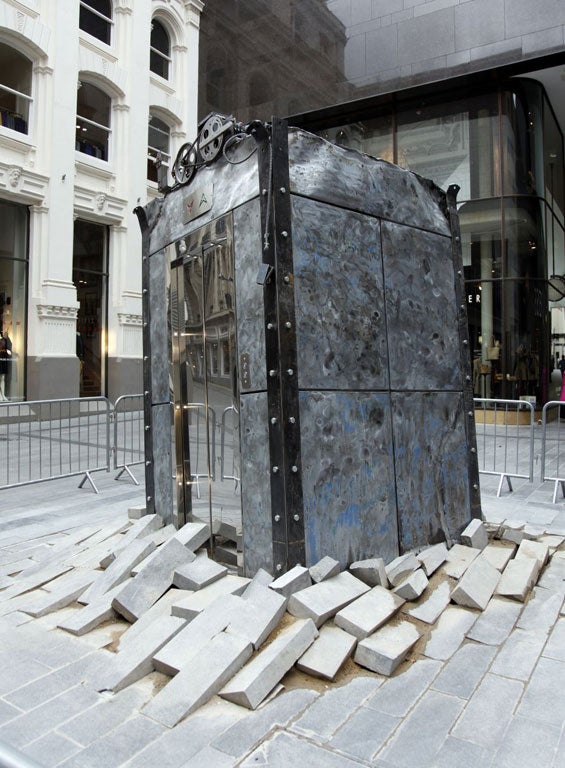Liverpool Blennial, Various venues, Liverpool
Youthful agitprop, a door that goes nowhere, and some cracking community work – it's a shame about the weather, but this art-fest is worth a soaking

It's a day of driving rain and I'm in Liverpool to visit the Biennial, with the work of more than 60 artists spread across the city. Clearly I am going to get very wet, but armed with a free map I set out from Lime Street Station still hoping to enjoy what to me is the pleasure of such festivals: finding art in unexpected places, access to buildings not normally open to the public, and the chance of discovering something fresh.
I am immediately warmed by a red neon sign snaking across the front of St George's Hall. "The right to right" it reads. This turns out to be the title for a campaign that features a broadsheet manifesto distributed around the city. The paper contains an essay on how to negotiate our rights when so often one person's rights conflict with another's. And who decides who has rights anyway? It's a classic piece of youthful agitprop by artists Libia Castro and Olafur Olafsson which perfectly embodies the spirit of this festival.
Next, it's down to the Mersey and the Cunard Building, the once grand Edwardian offices and passenger terminal of the famous shipping line. Inside, the marble halls are now empty commercial units lined with carpet tiles and strip lights. Like much of Liverpool, the space seems to be searching for a new purpose. And this question – what is the role of a post-industrial city in the 21st century? – is the subject of the installation by Superflex on the ground floor. Hanging from the ceiling are banners on to which genuine "To Let" signs from around Liverpool have been copied. From their sheer number and suggestions for uses – restaurant, bar, flat – the desperate nature of the search for tenants and purpose becomes palpable.
If this uncertain future is disturbing, then there is also the chance to wallow in the past. In one room the Brazil-based artist Runo Lagomarsino has shipped over a colourful statue of a macaw from his neighbour's garden in Sao Paulo and placed it opposite a vintage poster for an Amazon cruise that depicts a similar parrot. This wonderfully nutty meeting of birds not only references Liverpool's sea-going past, but engages with the "hospitality" theme of this year's Biennial. While rich travellers enjoyed journeys to exotic places, how welcoming were the British when the people of those places came calling back?
Further along the Pier Head from the Cunard Building is Tate Liverpool. It's quite right that it should provide some meat at the heart of the Biennial but somehow the exhibition it calls Thresholds comes across as a curating exercise. Familiar works from Tate's collection which have anything to do with immigration or tourism have been thrown together in the hope that they might add up to a comment on hospitality. It's worth a look but you don't want to stay long when there's so much new work to explore outside.
Next to the Tate there is a temporary pavilion designed by trendy architect David Adjaye to house a film installation by American artist Doug Aitken. Inside, a multi-screen projection shows Aitken's interviews with a dozen or so creatives, including actress Tilda Swinton and musician Jack White. Their discussions on the nature of creativity are interesting, but a well-edited TV documentary would have handled it better and the presence of the smug artist in the interviews is irritating.
On my way through the city's new shopping precinct I come across two works in the street. A shiny metal doorway marked "VIP" stands marooned on the pavement, impossible to open and leading nowhere. This is Elmgreen and Dragset's comment on the empty world of celebrity. Further on, a dented metal lift looks as if it has crashed through the pavement. The Lift by Oded Hirsch glows with sinister lights and the doors look ready to open. Aliens? Doctor Who? What strangers might appear and how would we greet them?
In the criss-cross of Georgian streets to the east is the Bluecoat art centre. Here artist Dora Garcia has set up a TV studio offering the chance to join a TV debate about Liverpool, its culture and its future. This is community art that crackles with life.
My last call is The Monro, a pub in a Georgian townhouse where Markus Kahre has transformed the first floor into creepily neat hotel rooms. Here you cross that strange line between guest and intruder, before being unsettled by a clever visual trick.
Back at the station I am soaked through and have barely touched the surface of the many things this Biennial has to offer. I would have liked to go to Everton Park where artists are working on a landscape project, and to the pop-up art café at Edge Hill Station on the special poetry train. There are also two huge fringe exhibitions, the New Contemporaries and the John Moores Painting Prize. The whole point of biennales is that they are a pick'*'mix and this one is definitely worth a rummage.
To 25 Nov (www.biennial.com)
Subscribe to Independent Premium to bookmark this article
Want to bookmark your favourite articles and stories to read or reference later? Start your Independent Premium subscription today.

Join our commenting forum
Join thought-provoking conversations, follow other Independent readers and see their replies